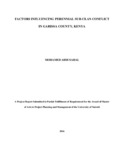| dc.description.abstract | In most communities globally, conflicts are mainly as a result of contention over management and access to natural resources mostly pasture for livestock and water. Clan conflicts in the pastoralists communities in Garissa County over access to resources is not a new phenomenon and had been a constant feature since time immemorial, but of late the frequency of these conflicts over access to water and pasture have been increasing owing to the frequent droughts, large herds of livestock kept by the pastoralists and the dwindling water and pasture resources available to support these large herds of animals. The general objective of the study was to determine the factors that influence perennial sub-clan conflict in Garissa County. The study specifically sought; to assess the influence of access and scarcity of key resources on perennial sub-clan conflict in Garissa County, Kenya; to establish the influence of instigated administrative boundaries on perennial sub-clan conflict in Garissa County, Kenya; to examine the influence of politics and administrative personnel on perennial sub-clan conflict in Garissa County, Kenya; and to establish the influence of inherent attitudes and cultural beliefs on perennial sub-clan conflict in Garissa County, Kenya. The study used a descriptive survey research design and its population constituted of 400 randomly selected community members from 6 sub-counties of Garissa County, and 12 community leaders elders of Garissa County. The study used Social Statistical Package for Social Science (SPSS) to summarize the quantitative data. This study established a strong correlation between; access and scarcity of key resources and perennial sub-clan conflict in Garissa County, politics and administrative personnel and perennial sub-clan conflict in Garissa County, inherent attitudes and cultural beliefs and perennial sub-clan conflict in Garissa County, and instigated administrative boundaries and perennial sub-clan conflict in Garissa County. This strong correlation suggests that when one factor increases, perennial sub-clan conflict in Garissa County, Kenya increases. The study therefore concludes that access and scarcity of key resources, politics and administrative personnel, inherent attitudes and cultural beliefs and instigated administrative boundaries influence perennial sub-clan conflict in Garissa County, Kenya. The study recommends there is need youth empowerment through job creation; curbing feasibility study and environmental impact assessment establishment of future administrative units and sinking of boreholes; prosecution of perpetrators of perennial sub-clan conflicts because currently compensation is done by clansmen; and economic empowerment for the youth to curb manipulation by the politicians and by extension radicalization | en_US |



